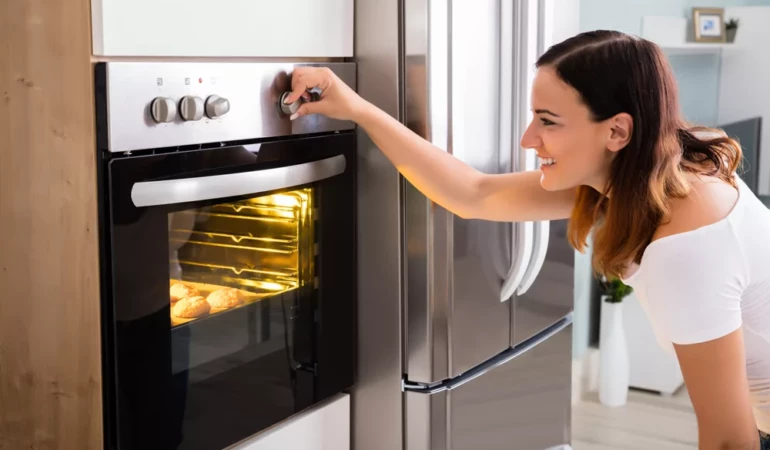While the “Self-Clean” mode is designed to be safe, it can put certain oven components at risk due to the high temperatures involved. Having an appliance repair professional on standby when using this feature is advisable, as approximately 85% of oven service calls occur immediately or shortly after utilizing the “Self-Clean” function.

Introducing the “Self-Cleaning” Feature in Ovens
The highly anticipated “Self Cleaning” feature in electric or gas ovens is a miraculous solution that eliminates the need for manual scrubbing, allowing you to press a button, wait for approximately four hours, and effortlessly wipe away burnt leftovers from your oven’s interior. However, there’s a small catch: every time you use the “Self Clean” function, it’s advisable to have an appliance repair professional on standby, as approximately 85% of oven service calls occur immediately or shortly after utilizing this feature. This article aims to shed light on the process and potential issues associated with the “Self Clean” mode, empowering you with knowledge before seeking any complicated and potentially expensive services.
PART ONE – Understanding the “Self-Clean” Mode
The first phase of the “Self-Clean” mode:
The oven’s locking system is activated through an automatic mechanism involving an electric motor and switches, ensuring the door is locked securely. This is a crucial safety feature present in all ovens.
The second phase of the “Self-Clean” mode:
During this phase, the top and bottom heating elements are activated. To effectively incinerate all remnants into black scales and dust, the oven’s temperature must rise much higher than during regular cooking, reaching temperatures as high as 600-700 degrees Celsius (above 1000 degrees Fahrenheit) and maintaining it for 3-4 hours.
The third phase of the “Self-Clean” mode:
This phase involves the cooling down process and unlocking of the oven. The automatic system waits for the oven’s temperature to drop safely before unlocking the latch and opening the door.
PART TWO – Components at Risk During the “Self Clean” Mode
- The locking mechanism:
It’s common for appliance technicians to receive calls when the oven door gets stuck immediately after the “Self Cleaning” process. - Safety elements – thermostats or thermal fuses:
These components act as watchdogs for excessive heat. Positioned on top or along the oven walls, they are designed to interrupt the oven’s operation if the temperature becomes too high, safeguarding against potential damage. - Control units – electronic boards and touch panels:
Located on top of the oven, these “brains” are susceptible to the intense heat generated during the “Self Clean” mode. The combination of strong heat and delicate electronics can lead to malfunctions such as error codes, automatic start/stop, or unresponsiveness, necessitating an expensive visit from an appliance technician. - Wires and contact terminals:
Electrical wires run through the oven, distributing electricity, and are protected by thermal insulation. However, the prolonged and intense heat of the “Self Clean” mode can cause insulation melting and wiring damage. Diagnosing such issues can be challenging and require multiple service visits. - Internal components within the oven cavity:
Items like light bulbs, glass housings, thermal sensors, and enamel layers can crack or deteriorate under the extreme conditions of the “Self Clean” mode.
Inside the Oven after the “Self Clean” Mode
The provided image showcases the appearance of the locking system and wiring after multiple “Self Clean” cycles. Although functional, this is how they look behind their shiny stainless covers.
In conclusion, as the oven owner, deciding to continue utilizing the “Self Clean” feature or revert to the traditional hands-on scrubbing approach is entirely yours. Our goal is to provide you with appliance repair services whenever necessary. Best of luck with your choice.
Frequently Asked Questions
Is the "Self-Clean" mode safe to use?
What happens during the "Self-Clean" mode?
The “Self-Clean” mode has three phases:
- The oven’s locking system activates, securing the door safely.
- The top and bottom heating elements are activated, raising the oven’s temperature much higher than during regular cooking, reaching temperatures as high as 600-700 degrees Celsius (above 1000 degrees Fahrenheit) and maintaining it for 3-4 hours.
- The oven cools down, and the automatic system unlocks the door when it’s safe to do so.
What components are at risk during the "Self-Clean" mode?
Several components are vulnerable to damage during the “Self-Clean” mode, including:
- The locking mechanism, which may cause the oven door to get stuck.
- Safety elements, such as thermostats or thermal fuses, are designed to interrupt the oven’s operation if the temperature becomes too high.
- Control units, electronic boards, and touch panels located on top of the oven can malfunction due to the intense heat.
- Electrical wires and contact terminals are protected by thermal insulation, which may suffer damage from prolonged and intense heat.
- Internal components within the oven cavity, such as light bulbs, glass housings, thermal sensors, and enamel layers, which can crack or deteriorate under extreme conditions.
What should I consider before using the "Self-Clean" mode?
As an oven owner, it’s essential to weigh the convenience of the “Self-Clean” feature against the potential risks and damages it may cause to the oven’s components. If you decide to use the “Self-Clean” mode, having a professional appliance repair service on standby can help address any issues arising during or after the process. Alternatively, you may choose the traditional hands-on scrubbing approach for cleaning your oven. The choice is entirely yours, and we are here to provide appliance repair services whenever necessary.
What are the potential issues with the control units during the "Self-Clean" mode?
The combination of intense heat and delicate electronics in the control units can lead to various malfunctions, including error codes, automatic start/stop, or unresponsiveness. If such issues occur, an expensive visit from an appliance technician may be necessary to resolve them.
